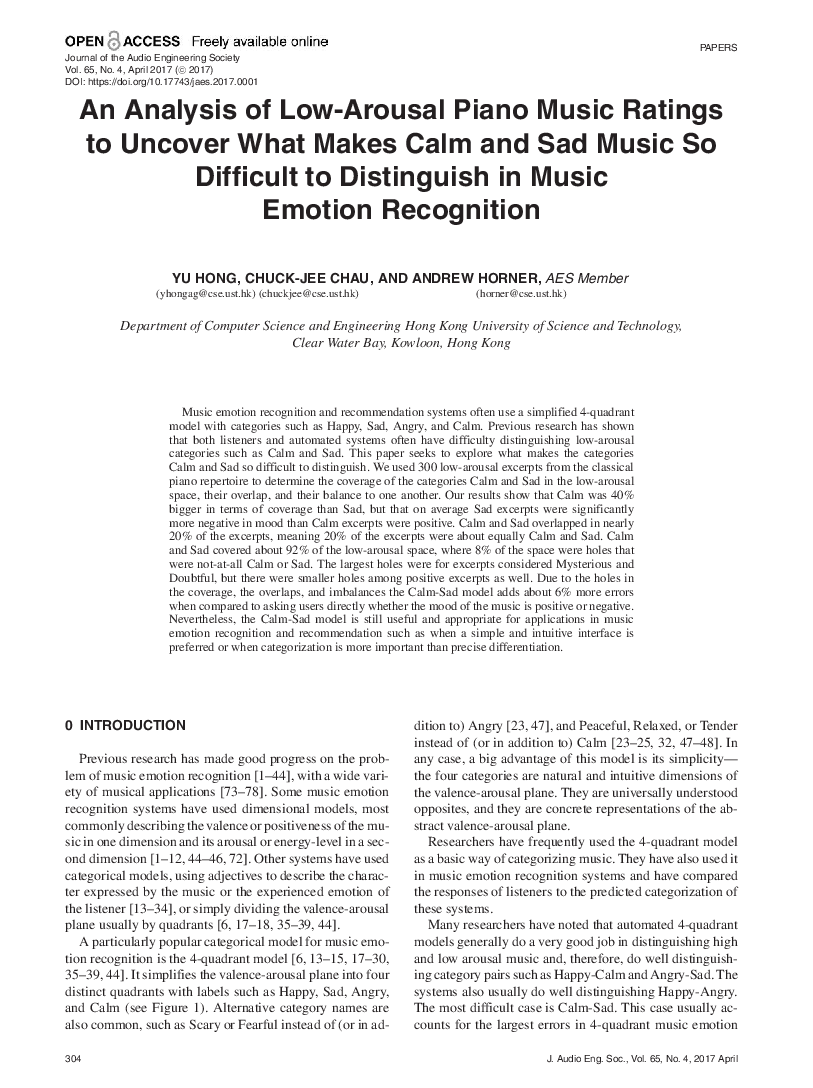Home / Publications / E-library page
You are currently logged in as an
Institutional Subscriber.
If you would like to logout,
please click on the button below.
Home / Publications / E-library page
Only AES members and Institutional Journal Subscribers can download
Systems that recognize the emotional content of music and systems that provide music recommendations often use a simplified 4-quadrant model with categories such as Happy, Sad, Angry, and Calm. Previous research has shown that both listeners and automated systems often have difficulty distinguishing low-arousal categories such as Calm and Sad. This paper explores what makes these categories difficult to distinguish. 300 low-arousal excerpts from the classical piano repertoire were used to determine the coverage of the categories Calm and Sad in the low-arousal space, their overlap, and their balance to one another. Results show that Calm was 40% bigger in terms of coverage than Sad, but on average, Sad excerpts were significantly more negative in mood than Calm excerpts that were positive. Calm and Sad overlapped in nearly 20% of the excerpts, meaning 20% of the excerpts were about equally Calm and Sad. Calm and Sad covered about 92% of the low-arousal space. The largest holes were for excerpts considered Mysterious and Doubtful. Due to the holes in the coverage, the overlaps, and imbalances, the Calm-Sad model adds about 6% more errors when compared to asking users directly whether the mood of the music is positive or negative. Nevertheless, the Calm-Sad model is still useful and appropriate for many applications.
Author (s): Hong, Yu; Chau, Chuck-Jee; Horner, Andrew
Affiliation:
Department of Computer Science and Engineering Hong Kong University of Science and Technology, Clear Water Bay, Kowloon, Hong Kong
(See document for exact affiliation information.)
Publication Date:
2017-04-06
Import into BibTeX
Permalink: https://aes2.org/publications/elibrary-page/?id=18563
(619KB)
Click to purchase paper as a non-member or login as an AES member. If your company or school subscribes to the E-Library then switch to the institutional version. If you are not an AES member Join the AES. If you need to check your member status, login to the Member Portal.

Hong, Yu; Chau, Chuck-Jee; Horner, Andrew; 2017; An Analysis of Low-Arousal Piano Music Ratings to Uncover What Makes Calm and Sad Music So Difficult to Distinguish in Music Emotion Recognition [PDF]; Department of Computer Science and Engineering Hong Kong University of Science and Technology, Clear Water Bay, Kowloon, Hong Kong; Paper ; Available from: https://aes2.org/publications/elibrary-page/?id=18563
Hong, Yu; Chau, Chuck-Jee; Horner, Andrew; An Analysis of Low-Arousal Piano Music Ratings to Uncover What Makes Calm and Sad Music So Difficult to Distinguish in Music Emotion Recognition [PDF]; Department of Computer Science and Engineering Hong Kong University of Science and Technology, Clear Water Bay, Kowloon, Hong Kong; Paper ; 2017 Available: https://aes2.org/publications/elibrary-page/?id=18563
@article{hong2017an,
author={hong yu and chau chuck-jee and horner andrew},
journal={journal of the audio engineering society},
title={an analysis of low-arousal piano music ratings to uncover what makes calm and sad music so difficult to distinguish in music emotion recognition},
year={2017},
volume={65},
issue={4},
pages={304-320},
month={april},}
TY – paper
TI – An Analysis of Low-Arousal Piano Music Ratings to Uncover What Makes Calm and Sad Music So Difficult to Distinguish in Music Emotion Recognition
SP – 304 EP – 320
AU – Hong, Yu
AU – Chau, Chuck-Jee
AU – Horner, Andrew
PY – 2017
JO – Journal of the Audio Engineering Society
VO – 65
IS – 4
Y1 – April 2017